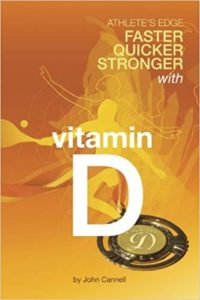BOOK REVIEW
By Katherine A. Carroll, NTP
 Athlete’s Edge: Faster, Quicker, Stronger with Vitamin D by John Cannell, M.D. (ISBN 978-0-9774272-9-1; 2011 by John Cannell, M.D., paperback, 318 pages; $19.95.)
Athlete’s Edge: Faster, Quicker, Stronger with Vitamin D by John Cannell, M.D. (ISBN 978-0-9774272-9-1; 2011 by John Cannell, M.D., paperback, 318 pages; $19.95.)
Few books I’ve read have appealed to my logic and expanded a subject so greatly in the space of a few hundred pages, in this case Vitamin D. While Dr. Cannell approaches Vitamin D with the honest pretext of improving athletic ability, he admits that he wanted to capture a certain audience that would not resonate with a rote list of ailments and diseases due to Vitamin-D deficiency from multiple sclerosis and cancer to heart disease, osteoporosis, and chronic pain, among many others. Namely, he wanted to get the attention of kids, having two daughters of his own.
While one would think children wouldn’t have any problems with low Vitamin-D levels because they are outdoors more than most adults, 86% of young gymnasts complained of chronic musculoskeletal pain and were tested to have low levels of Vitamin D. They practice inside. Outside, their mothers most likely slather them with sunscreen, unaware that they need proper exposure to the Sun.
Dr. Cannell demonstrates how the American Medical Association’s edict against sunshine in the 1980s ended a historical love affair with the Sun that humans have not only enjoyed, but been nurtured and healed by since time began. Instead of determining what baseline levels should be – by examining the Vitamin-D levels of lifeguards for instance or famers who work at the equator – the AMA arbitrarily sets a level far too low to maintain health, all while advising us to use sunscreens and avoid sun exposure, thus compounding the deficiency problem.
Dr. Cannell cuts through massive amounts of studies on skin cancer, internal cancers, and chronic pain to show that we simply cannot trust medical science without relying on common sense and referencing our entire historical relationship with the Sun. The studies he presents are far from dry. They are compelling and make perfect sense. Watching fractures decrease and bone density increase in the hospitalized elderly – in sharp contrast with their unfortunate neighbors in the sun-less ward who lost bone density and had more fractures –was one exciting proof that old-fashioned sunshine is more healing than the AMA has led us to believe. But the fault simply cannot be laid at the door of medicine. The general public often doesn’t do its homework to direct or even participate in its own health care.
Also of interest is the visual Dr. Cannell gives of Vitamin D “filling the uppermost mountain pool,” i.e., maintaining blood calcium levels that will cause death if not maintained. Once we are sufficient in this uppermost pool, the excess can then spill over to service over 1000 different genes, five percent of our genome, switching them on or off as needed. Obviously, Vitamin D is a major player in the maintenance of health; and it isn’t really a vitamin at all, it is a prehormone. The statistics he quotes over and over showing gross insufficiency are enough to make most of us run to our vitamin pantries to make sure we are taking the correct form, D3, and also getting Sun or at least into a tanning bed.
What is sad is our reliance upon the AMA or dermatologists, whose professional edicts defy the very common sense our own mothers or grandmothers had when they admonished us to “go play outside” –and they didn’t coat us with sunscreen before we did. A recent study in Boston found 50% of mothers and 65% of infants at critically low levels of Vitamin D (below 12ng/ml – enough to cause rickets in infants and osteomalacia in adults; normal levels being 40ng/ml and preferably 50ng/ml). So, Dr. Cannell’s focus on the impact of breast feeding these infants in an often undiagnosed, deficient state leads him to condemn the La Leche League for not advising that infants be supplemented with Vitamin D.
As far as high-performance athletes go, his discussion of stress fractures due to exercise is both interesting and important. Other common complaints among athletes include low-back pain, chronic musculoskeletal pain, and overreaching, which are also common among the general population. Again and again, we find suboptimal levels of Vitamin D as the culprit. Indeed, adequate supplementation is the key that heals these fractures (along with calcium, magnesium, and Vitamin K). Remember, the more an athlete overreaches and produces inflammation, the more Vitamin D is needed. So, while 5,000 IUs might be right for most of us, measuring levels annually is vital to ensuring adequate Vitamin-D levels.
Dr. Cannell reveals that many physicians are testing the wrong Vitamin D, testing for “activated” versus 25(OH)D. This “activated” level should not be used as a measure of sufficiency, as activated Vitamin-D levels will usually be stable. Instead, according to Dr. Cannell, ask your physician to test 25(OH)D. If it is not sufficient, then use a combination of sunshine, tanning beds, and supplementation to achieve sufficiency. Vitamin D is fat soluble, so be sure to take it with fat for better absorption.
If you would like to test your own level, Dr. Cannell advises using a simple finger prick and he provides a competent laboratory source for his readers. His organization, the Vitamin D Council, can be found at www.vitamindcouncil.org; but I recommend that you buy and read this excellent book to support his important work and to better your own health.

No Comments Yet